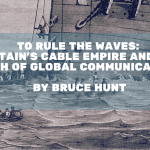Institute for Historical Studies, Wednesday May 5, 2021
The History Faculty New Book Series presents:
Imperial Science: Cable Telegraphy and Electrical Physics in the Victorian British Empire
(Cambridge University Press, 2021)
A book talk and discussion with
BRUCE J. HUNT
Associate Professor of History
The University of Texas at Austin
https://liberalarts.utexas.edu/history/faculty/huntbj
In the second half of the nineteenth century, British firms and engineers built, laid, and ran a vast global network of submarine telegraph cables. For the first time, cities around the world were put into almost instantaneous contact, with profound effects on commerce, international affairs, and the dissemination of news. Science, too, was strongly affected, as cable telegraphy exposed electrical researchers to important new phenomena while also providing a new and vastly larger market for their expertise. By examining the deep ties that linked the cable industry to work in electrical physics in the nineteenth century – culminating in James Clerk Maxwell’s formulation of his theory of the electromagnetic field – Bruce J. Hunt sheds new light both on the history of the Victorian British Empire and on the relationship between science and technology.’Lucid, brilliantly well-informed and replete with fresh insights, Imperial Science is destined to be an indispensable classic. Bruce J. Hunt gives us a rich account of how radical developments in cable telegraphy and the theory of electromagnetism were intertwined, with profound consequences for the everyday lives of millions of people all over the world.’
–Graham Farmelo, Churchill College, University of Cambridge
‘Well before the internet, information flowed through British submarine cable telegraphy. Bruce J. Hunt’s fascinating study explores how physicists and telegraph engineers managed competing methods and demands to create this first global communications system. These nerves of empire transformed international affairs, accelerated commerce, provided rapid access to news, and revolutionized physics.’
–Kathryn Olesko, Georgetown University
With impressive skill, Bruce J. Hunt brings together the commercial and engineering practices of Victorian telegraphy with the construction of the new physics of electromagnetic field theory. In so doing, he powerfully reinvigorates the history of nineteenth-century physics as a major academic arena grounded upon, but not determined by, imperial engineering and technology.’
–Crosbie Smith, University of Kent
Dr. Bruce Hunt is an Associate Professor in the Department of History, at the University of Texas at Austin, where he specializes in the history of science and technology. He is the author of The Maxwellians (Cornell University Press, 1991) and Pursuing Power and Light: Technology and Physics from James Watt to Albert Einstein (Johns Hopkins University Press, 2011). Professor Hunt’s current work focuses on the relationship between technology and science in the 19th century, and particularly on the interaction between theory and practice in the Victorian telegraph industry. He also has strong interests in the history of nuclear weapons and of evolutionary theory. His teaching interests include the history of modern science, the history of technology, and modern British history. Read more about this work on his profile page, and personal website.
This discussion is part of the IHS History Faculty New Book Series.
Sponsored by: Institute for Historical Studies in the Department of History, and Center for European Studies.
The views and opinions expressed in this article or video are those of the individual author(s) or presenter(s) and do not necessarily reflect the policy or views of the editors at Not Even Past, the UT Department of History, the University of Texas at Austin, or the UT System Board of Regents. Not Even Past is an online public history magazine rather than a peer-reviewed academic journal. While we make efforts to ensure that factual information in articles was obtained from reliable sources, Not Even Past is not responsible for any errors or omissions.




